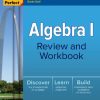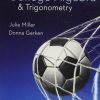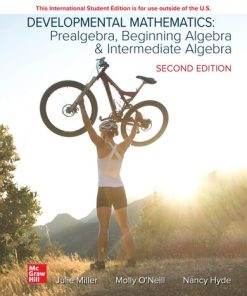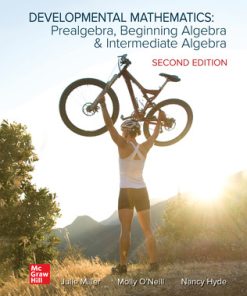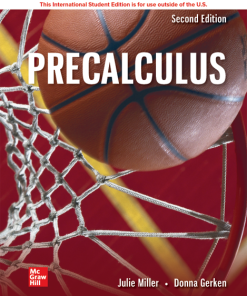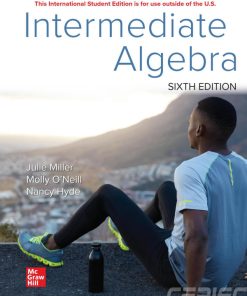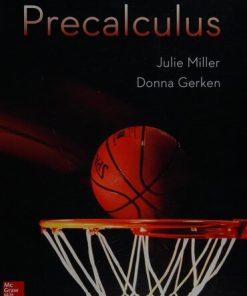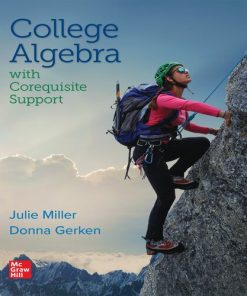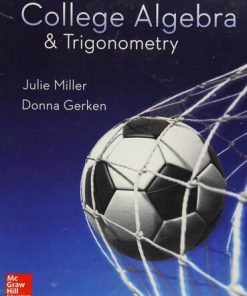(EBOOK PDF)Precalculus 1st Edition by Julie Miller 0078035600 9780078035609 full chapters
$50.00 Original price was: $50.00.$25.00Current price is: $25.00.
Precalculus 1st Edition by Julie Miller – Ebook PDF Instant Download/Delivery:0078035600, 9780078035609
Full download Precalculus 1st Edition after payment
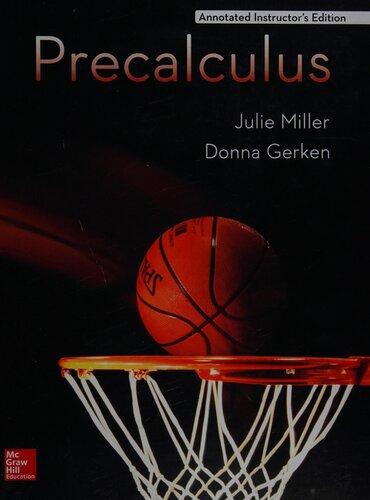
Product details:
• ISBN 10:0078035600
• ISBN 13:9780078035609
• Author:Julie Miller
Julie Miller wrote her developmental math series because students were coming into her Precalculus course underprepared. They weren’t mathematically mature enough to understand the concepts of math nor were they fully engaged with the material. She began her developmental mathematics offerings with intermediate algebra to help bridge that gap. The Precalculus series is a carefully constructed end to that bridge that uses the highly effective pedagogical features from her fastest growing developmental math series. What sets Julie Miller’s series apart is that it addresses course issues through an author-created digital package that maintains a consistent voice and notation throughout the program. This consistency–in videos, PowerPoints, Lecture Notes, and Group Activities–coupled with the power of ALEKS and Connect Hosted by ALEKS, ensures that students master the skills necessary to be successful in Precalculus and can carry them through to the calculus sequence.
Precalculus 1st Table of contents:
Chapter 1: Analyzing Trigonometric Functions
1A: The Cosine and Sine Functions
This investigation introduces radian measure. The text is careful not to equate degree and radian measurement (such as one would equate inch and centimeter measurement): radian measure is the length of an arc of the unit circle. 1 radian, then, is an arc of the unit circle with length 1 unit. They do work on the customary problems of converting between degrees and radians, but the goal is to enforce the concept that a radian is a distance measurement, not another way to measure angles. They then review the graphs of the cosine and sine functions, and develop an understanding of a periodic function. Finally, they begin to solve equations that involve cosine and sine.
1B: Other Trigonometric Functions
In Investigation 1B, students round out the list of trigonometric functions, learning tangent and the three reciprocal functions, secant, cosecant, and cotangent. They review the graphs of these functions, learn about how each function can be demonstrated on the unit circle, and work with some basic identities. They also review the definitions of inverse function and one-to-one, and learn how to restrict the domain of cosine, sine, and tangent in order to define their inverses.
1C: Trigonometric Functions and their Graphs
This investigation emphasizes the idea that trigonometric functions are “functions as usual” — once students are familiar with the graphs of the functions defined by f(x)=cos x and f(x)= sin x, the sinusoidal functions emerge from the same transformations that students used beginning in Algebra 1. The lessons de-emphasize the memorization of formulas plucked from coefficients — instead, amplitude and phase shift are motivated with concrete examples.
Chapter 2: Complex Numbers and Trigonometry
2A: Graphing Complex Numbers
In this investigation, students explore polar form as a way to represent complex numbers. The exercises lead up to the Multiplication Law for complex numbers, which highlights the connection between complex numbers and transformational geometry: a vector can be dilated and rotated by performing one multiplication.
2B: Trigonometric Identities
In this investigation, students explore ways to build and prove trigonometric formulas and identities. Students learn that by using complex arithmetic, they can easily prove trigonometric facts that can prove quite difficult to show strictly using algebra and geometry of the real plane.
2C: DeMoivre’s Theorem
In this investigation, students study the roots of unity. This study is especially suited for showing the connections between algebra, geometry, and analysis: using trigonometric functions to represent complex numbers allows one to use analytic methods to solve algebraic problems (and vice versa), connecting the roots of xn – 1 = 0 and the regular n-gon allows students to use the power of algebra to solve geometric problems and to use geometric methods to get algebraic insights, calculating with “cyclotmic integers (complex numbers that are linear combinations of nth roots of unity with integer coefficients) shows once again how one can model algebraic systems with polynomials and computer algebra systems.
Chapter 3: Analysis of Functions
3A: Analysis of Polynomial Functions
Students look at the graphs of many different polynomial functions and develop a general description of the properties of these functions, especially for polynomials of degree three and four, including their behavior for extremely large and small values of x. Continuity is defined, and students develop both a formal and an informal understanding of what it means. Through key theorems, including the Intermediate Value Theorem, students draw conclusions about the number of roots possible for a polynomial function of given degree. They calculate the slope of the line tangent to the graph of polynomial functions at a point by finding the limit of the secant slope as one of the two points that determines the secant line approaches the other. They also use iterated long division, the method of undetermined coefficients, and technology to write the Taylor expansion for various polynomial functions about a point, and use this expansion to find the equation for the tangent to a polynomial graph at a point. Along the way, they develop an informal understanding of what the slope of this tangent means about the polynomial functions.
3B: Analysis of Rational Functions
Students analyze the graphs of rational functions. As with polynomial functions they look at many graphs and develop a general description of the properties of rational function graphs, including the types of discontinuity that can occur and the behavior of these graphs for extremely large and small values of x. Using the fact that these graphs are continuous for points where the function is defined, students find equations for the slope of the tangent to a rational function graph at a point in much the same way as they did for polynomial functions.
3C: Analysis of Exponential and Logarithmic Functions
This type of analysis continues to exponential and logarithm functions. The first order of business is to define e, and this is done through an analysis of compound interest. Students see that as interest is compounded more and more frequently the yield of the account is greater, but that there seems to be a limit to how much it can grow. This leads to the definition of continuously compounded interest and a limit definition of e. Students also learn a factorial definition for e and show the two definitions are equivalent. The function y = ln x is introduced. Students see how to write any exponential function in terms of e and any logarithm function in terms of the natural logarithm. Then students analyze these functions y = e^x and y = ln x as in the first two investigations, finding the equation for the tangent to the graph at a point.
Chapter 4: Combinatorics
4B: Permutations and Combinations
In this investigation, students see a formal introduction to permutations and combinations.
4C: Making Connections
Here students revisit Pascal’s triangle with the goal of making sense of connected ideas.
4A: Learning to Count
In this investigation, students begin their work in Combinatorics by diving into fairly challenging combinatorial problems, before they see formal strategies for solving those problems. At the end of the investigation, they see three strategies: the “box method,” building tree diagrams, and “solving a smaller problem.”
Chapter 5: Functions and Tables
5A: Mathematical Induction
Students are reminded about defining functions recursively or with a closed form, then focusing on when two such functions might agree. Mathematical induction is used to justify that two such rules will always agree for any integer input.
5B: Newton’s Difference Formula
Students explore difference tables and learn about the connections between how difference tables are built and how Pascal’s Triangle is constructed. These observations lead to Newton’s Difference Formula, a method that can be used to find a function that fits a table.
5C: Closed-form and Recursive Functions
Students explore different rules used to recursively define functions, and methods used to find a closed-form function fitting the same rule. The investigation includes a look at the closed-form functions for investment situations and for Fibonacci numbers, among others.
Chapter 6: Analytic Geometry
6A: Coordinate Geometry
Students see and make more connections between algebra and geometry, by using algebraic techniques to prove geometric results. However, instead of demonstrating specific instances of geometric theorems through coordinates, students choose strategic coordinate systems to construct true general proofs of geometric results.
6B: Conic Sections
Students explore conic sections from many different perspectives. Students see these curves as the intersection of a plane with an infinite double cone, as a collection of points with specific distance relationships with points and lines, and as graphs of equations in two variables. They make connections among all these different representations as they compare and contrast the curves and their equations.
6C: Vector Algebra and Geometry
Students use the matrix algebra they’ve learned to operate on vectors, which are ordered pairs in the plane or ordered triples in three-space. They use vector methods to connect to geometry, which results in even more synergy between algebra and geometry. As students come to be able to visualize the geometric results of algebraic operations on vectors, they learn more about the properties of those operations, and through vector methods they come upon completely new ways to think about geometric proofs in the coordinate plane. Vector methods are especially valuable because they translate much more easily to three-dimensional space that traditional coordinate methods.
Chapter 7: Probability and Statistics
7A: Probability and Polynomials
Students formalize the language to describe probability experiments and learn to calculate and make sense of expected value as a statistical measure of these experiments. They learn to create and use generating polynomials to calculate frequencies and probabilities.
7B: Expectation and Variation
Students calculate expected value, variance, and standard deviation, and draw conclusions about the algebraic structure of these functions. Students also explore Bernoulli trials and see how formulas for expected value and variance can be simplified in this restricted environment.
7C: The Normal Distribution
Students develop an informal understanding of the Central Limit Theorem. By looking at probability distributions for some very different probability experiments, students see how as the number of trials of the experiment increases the distributions come to resemble each other more and more. Eventually, they all come to resemble the bell-shaped curve of the normal distribution. Students learn to use this distribution as an approximation to one of their own distributions and to calculate with it.
Chapter 8: Ideas of Calculus
8A: Finding Areas of Shapes
Students begin by looking at the area of familiar shapes and then move on to thinking abut how to find the areas of irregular or “curvy” shapes.
8B: Finding Areas Under Curves
Students extend what they have learned and look at areas under the graphs of y=x^m between x=a and x=b for any positive integer m.
People also search for Precalculus 1st:
precalculus julie miller
precalculus julie miller pdf
precalculus julie miller answers
precalculus julie miller and donna gerken mcgraw hill
precalculus 2nd edition julie miller
Tags:
Precalculus Julie,Julie Miller,Julie Miller
You may also like…
Mathematics
Mathematics - Applied Mathematics
Uncategorized
Mathematics - Algebra
Uncategorized
Mathematics - Algebra
(EBOOK PDF)Precalculus 1st Edition by Julie Miller 0078035600 9780078035609 full chapters
Mathematics - Algebra
Uncategorized


